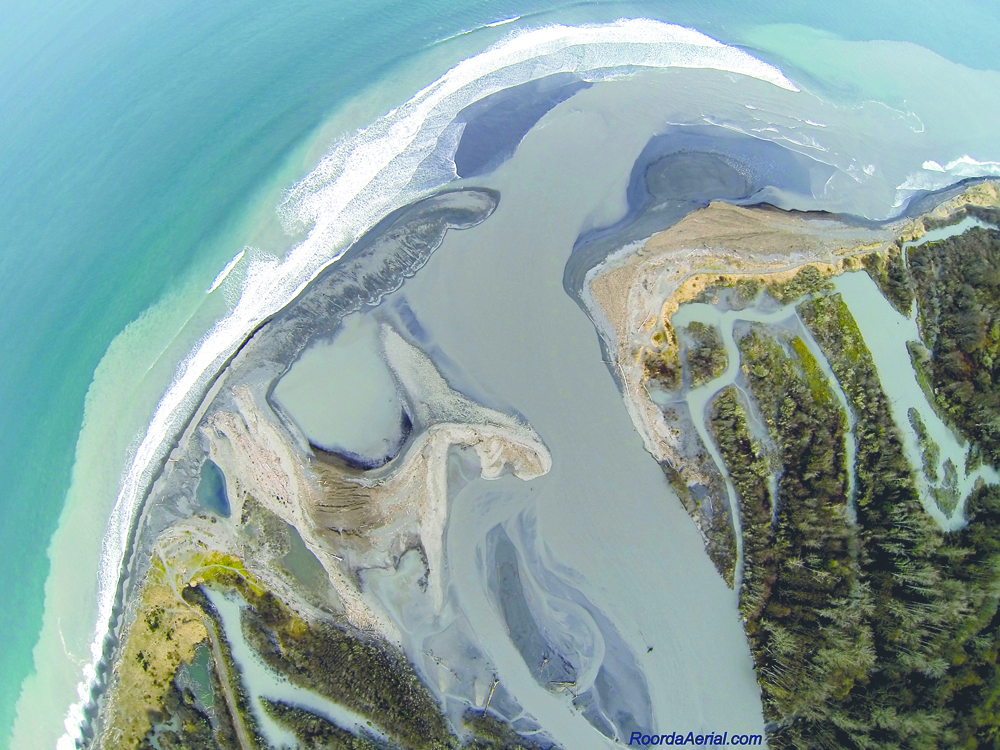PORT ANGELES — Sediment flowing from the Elwha River is creating new sandy beaches along the Strait of Juan de Fuca.
Much of the fine sediment released by the work to remove two dams has been dropped at the mouth of the Elwha River, where it runs into the Strait, creating sandy beaches and a growing spit where there were once only cobbles — the beginnings of a new, larger river delta.
“I’m surprised at how stable it is” now, said Ian Miller, a scientist with Washington Sea Grant who is studying the river mouth.
Miller added that the beach is expected to shift and that its future shape is uncertain.
The sandy beaches stretch into areas that were open water in November, and the river mouth now points slightly east, entering the Strait between a growing sandbar that extends from the western side of the river and growing beaches on the eastern side.
The land on the east side of the mouth is owned by the Lower Elwha Klallam tribe, while land on the west is split between a private landowner and the tribe, according to the Clallam County Assessor’s Office.
Miller and Andy Ritchie, a hydrologist with Olympic National Park, were among those who talked to a roomful of scientists, conservationists and area residents Wednesday morning at the Elwha Nearshore Consortium Workshop at Peninsula College.
Ritchie said the sand is drawn out of the river mouth by the exiting water, and the waves and tides push it back, creating an ebb and flow, and altering the shape of the river mouth.
The Elwha River already has moved 6 million cubic yards of sediment out of the now-empty lakebeds of what were formerly known as lakes Aldwell and Mills — and the flow is expected to pick up with spring runoff of the Olympic Mountains, Ritchie said.
So far, of the 28 million cubic yards of sediment that were estimated to clog the valley where Lake Mills once existed, 4.7 million cubic yards have been carried downstream.
At Lake Aldwell, 1.3 million cubic yards of the original estimate of 6 million cubic yards of sediment have washed downstream, Ritchie said.
The sediment washed out of the combined lakes is about 18 percent of what was there, he said, an estimated 34 million cubic yards.
This year’s spring flow is expected to increase the sediment in the water to previously unrecorded levels and will begin to move the gravel and other large sediment farther downstream, he said.
Nearly half of the coarse or larger sediment that is expected to wash out of the lakebeds is already gone, Ritchie said, with fine sediment expected to make up a larger portion of future sediment movement.
At this point, in some places the river has found its way to the original riverbed — as evidenced by very large tree stumps, he said — but in other locations, there is still up to 50 feet of sediment covering the original valley floor and riverbed.
Gravel from the lakebeds has moved into the middle reaches of the river, Ritchie explained.
Pools that formed when the river scoured out sand and gravel from the riverbed over the past 100 years have filled in, including a 14-foot-deep pool that was once the deepest pool in the river, he said.
Now, the middle reaches of the river have become smoother and braided, with sandbars, mid-channel islands — and faster water.
The change in the nature of the river has sped the water downstream, increasing flows from 4-6 feet per second to 8-10 cubic feet per second in that section, he said.
Dam removal began in September 2011 in the National Park Service’s $325 million Elwha River restoration project and remains ahead of schedule, said Brian Winter, Elwha River restoration project manager.
Elwha Dam, located 5 miles south of the mouth of the Elwha River, has been removed, and Lake Aldwell was drained by March 2012, and the former 212-foot Glines Canyon Dam, which held the larger Lake Mills, has been reduced to a 50-foot stub.
The gradual removal of the rest of Glines Canyon Dam will resume in April, once new filters are installed on the Port Angeles industrial water intake plant, Winter said.
—————–
PDN reporter Arwyn Rice can be reached at 360-452-2345, ext. 5070, or at arwyn.rice@peninsuladailynews.com.

